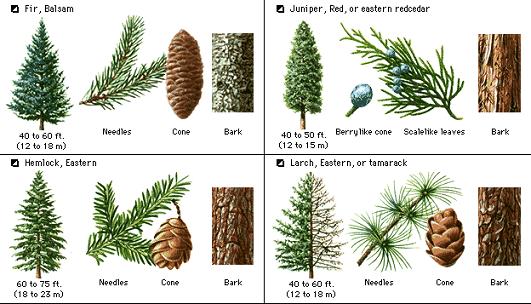
 |
|
BROADLEAF AND NEEDLELEAF TREES
|
|---|
| This section illustrates some of the chief characteristics of various broadleaf and needleleaf trees around the world. The drawings show the summer and winter appearance of each species. They also illustrate the leaf; the fruit or other seed-bearing structure; and, in most cases, the bark. For some species, the flower is shown. Each set of illustrations includes information about the tree's native geographic range-that is, the part of the world where the tree is most likely to be found. But a number of the species shown have spread or have been planted outside their native range. The average height of adult trees of each species is given in feet and in meters alongside the illustration of the tree's shape. |
 |
|---|

The drawings and other information in this section can help in identifying trees. For example, if the leaf and bark of a tree match the leaf and bark of one of the trees shown here, the tree should be fairly easy to identify. Tree guidebooks can provide additional help in identifying trees. Several guidebooks are listed in the Study aids at the end of this article.
Trees around the world
In some parts of the world, trees grow in thick forests. In other regions, they do not grow at all. To grow, trees need a period of more than two months without frost each year. The few trees that grow in the Arctic never reach full tree size. No trees can grow in the ice and bitter cold of Antarctica. Most trees also need at least 15 to 20 inches (38 to 51 centimeters) of rainfall a year. Only a few trees, such as the Joshua tree and some types of palms, can survive in deserts.
 |
|---|
Most broadleaf trees grow best in regions that are warm and moist at least three or four months of the year. Colder, dryer climates are better suited to most needleleaf trees. But some broadleaf trees, such as birches and willows, grow well in cool climates. Some needleleaf trees, including baldcypresses and various types of pines, need fairly warm climates. Palm trees grow in warm areas throughout the world, especially the wet and the dry tropics. Pandanus trees, cycads, and tree ferns grow mainly in the wet tropics and other warm, moist regions. Lily trees also thrive in warm areas, but they do not need so much moisture as do pandanus trees, cycads, and tree ferns.
Different kinds of trees also require different soils. Many needleleaf trees grow well in poor, sandy soil. But most broadleaf trees need more fertile soil. |
|---|
Contributor: Richard H. Waring, Ph.D., Professor Emeritus of Forest Ecology, Oregon State University. |
|
||||||||||||
|---|---|---|---|---|---|---|---|---|---|---|---|---|
|
|
||||||||||||